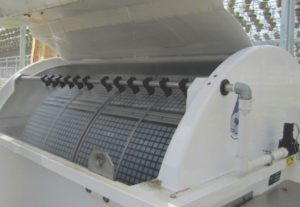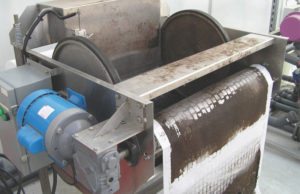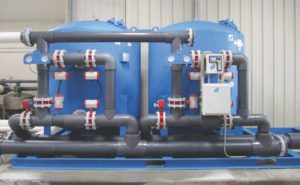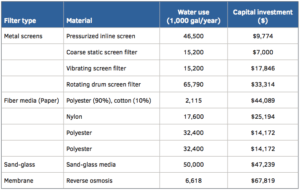The Cost of Filtration
How much does irrigation water cost your business? The true cost is more than just your monthly water bill. For example, well water includes a cost of digging the well, purchasing and maintaining a pump and electricity to pump water. In addition, if you treat water with filtration or chlorination, these treatments must be included.
In this three-part series, we summarize cost data from growers and suppliers. We break down the water cost into three components: (1) filtration, (2) sanitation and (3) water source. This information is helpful when choosing between treatment technologies. The more expensive your water source, the quicker the pay back on investment in capture and re-use of irrigation runoff.
Filtration Systems
Filtration is usually needed before sanitation treatments, to remove particles that can distribute sediment, pathogens and algae. These particles can clog irrigation lines and spread diseases. We evaluated a few of the many available filter types being used in commercial greenhouses. Examples are shown in Figures 1 through 7:
- Pressurized inline filter: pressurized water is passed through a screen filter that may be automatically or manually back-flushed. Unit tested had 100 micron pores (μm).

- Coarse static screen filter: a simple gravity- fed filter with large pore size (unit tested 400 μm) that has low operating cost and is often the first stage in filtration of ebb-and- flood return water.

- Vibrating screen filter: gravity-fed water is passed through a screen that vibrates rapidly to move particles to the edge of the screen and unclog screen pores. Unit tested 100 μm.

- Rotating drum filter: gravity-fed water is passed through a rotating screen which separates water and particles, and is continually sprayed to clean the screen pores. Unit tested 89 μm.

- Fiber media (“paper”) filters: gravity-fed water passes through a fabric which is indexed forward as the fabric clogs and water level backs up. Pore size varies depending on fabric type and depth.

- Sand-glass media filter: pressurized water was passed through a pressurized cylinder containing crushed glass. Pore size varies depending on sand-glass particles.

- Membrane filter: pressurized water removes particles and ions (such as sodium and chloride) from the water using reverse osmosis through very small pores (unit tested 0.01 μm).

Estimating the Costs of Water Treatment
Capital and operational cost data were obtained from large commercial greenhouse operations, and were calculated per 1,000 gallons of water filtered.
- Capital costs refer to the expenses incurred for purchase of the filtration system, shipment and installation. We applied a 10-year linear depreciation for all filtration systems. Therefore, the capital cost per 1,000 gallons equaled the upfront investment divided by 10 (depreciation years), divided by the water volume filtered (gal), and then multiplied by 1,000.
- Operational costs represent consumables which included filter component replacement, maintenance supplies, electricity, and labor required to run and maintain the equipment.
- Total costs represent the sum of the capital plus operational costs per 1,000 gallons of water filtered.
It is difficult to compare one filter with another based on data from commercial installations, because of variables such as material, flow rate, brand and pore size. This data should therefore be considered as examples. We recommend you undertake a similar type of cost analysis for your own operation after receiving cost estimates from filter suppliers. We also do not report here the filter efficiency (percent or concentration of particles removed), but we will report that in future articles.
Breaking Down the Costs
The major cost for most filters comes from the initial purchase and installation (Tables 1 and 2). However, supply costs are significant for fiber media filters, because of the need to purchase rolls of fabric. In general, little labor is required to maintain filtration systems, with the exception of specialized labor required to maintain reverse osmosis systems.

Screen filters. Screen filter cost is mainly attributed to the capital investment, ranging from $0.02 to $0.12 per 1,000 gallons of filtered water (Table 2). Screen filters require very little maintenance, and operation cost is mainly electricity. Multiple inline filters can be installed in pressurized systems with decreasing pore size to improve filter efficiency. Coarse static filters are a low cost option suitable as a first stage of treating gravity-fed return ebb- and-flood water, removing large particles and improving the efficiency of a second stage filter with smaller pore size and higher cost.

Fiber media (“paper”) filters. These filters had the highest consumable costs, because of the need to replace fabric rolls. The capital cost of synthetic fiber filtration ranged between $0.04 to $2.09 per 1,000 gallons, depending on the volume of water, and size of the filtration unit.
Costs varied widely between locations using fiber media filters. One greenhouse operation had a filter with high capital cost ($44,089) and excess capacity than the 2.1M gal of water treated. This grower also used the most expensive fiber rolls ($0.78 per 1,000 gallons) with no pre-filter. The total cost for this grower to filter ebb-and-flood water was a very high $2.97 per 1,000 gallons. In contrast, other operations treated significantly more water (>17.6M gal) with lower-priced fiber media filters (<$26K, Table 1). These examples emphasize the need to avoid high filtration costs by matching the technology capacity to the treated water volume.
Sand-glass filters. This filter had a low operating and total cost. Sand-glass filters are often used to filter large water volumes, especially pond water.
Membrane filters. Removal of very small particles and dissolved ions from water was expensive relative to other options, and also had the highest labor to maintain the system. A high level of pre-filtration with other coarser particle filters upstream of a membrane filter is necessary to avoid clogging of the membrane.
Take Home Messages
- Multiple stage filtration is generally recommended for treatment, to allow decreasing pore size with each subsequent filtration stage. Given the higher total cost of fiber media filters compared with screen and sand-glass filters, fiber media filtration may be most appropriate as a second filtration stage following an initial screen filtration in order to reduce the consumable cost of fiber rolls.
- Sizing equipment with excess capacity increases cost. Match the capacity of irrigation technology to the flow rate and volume in order to maximize profit.
- Screen filtration systems have lower total costs per volume of water compared with synthetic fiber filtration mainly because of a lower cost of consumables (electricity versus fiber rolls).
In the next issue, we will discuss about the cost of sanitizing water for pathogens and algae.
Acknowledgements. Thanks to funding support and collaboration from industry partner the Floriculture Research Alliance.


 Video Library
Video Library 




















